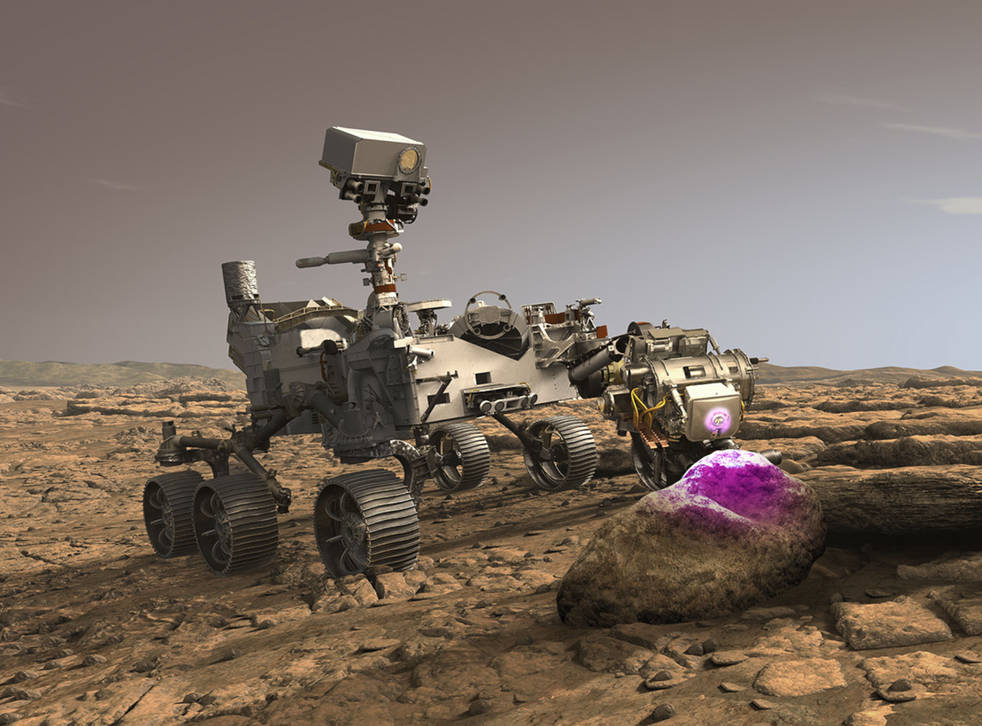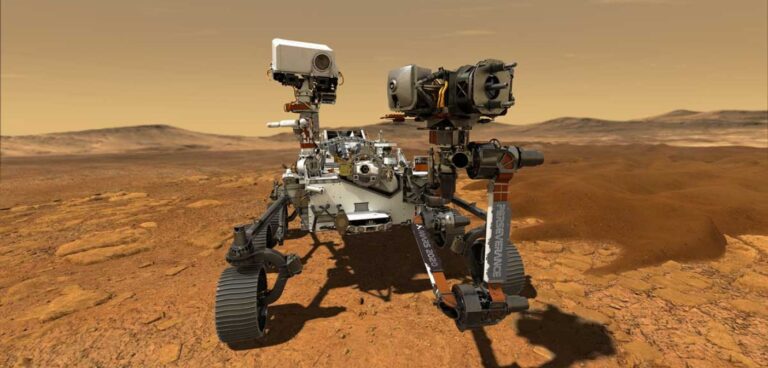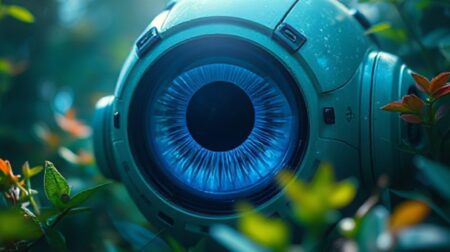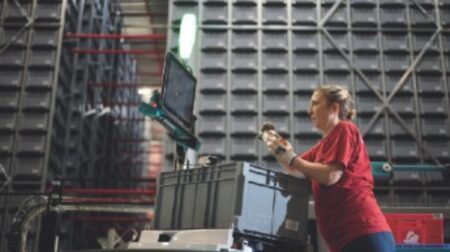The most advanced robotic explorer ever sent into deep space, NASA’s Perseverance rover has begun a two-year mission to search for signs of past life on the red planet. John Thornton reports…
On 30th July 2020, NASA’s Perseverance rover launched from Cape Canaveral Space Force Station in Florida aboard a United Launch Alliance Atlas 5 rocket-fired spacecraft on a US$2.7bn (£2bn) mission to Mars. Packed with ground-breaking technology, it took with it the first-ever interplanetary aircraft, sophisticated instruments to search for signs of ancient life and drill-to-core samples for eventual return to Earth.
Preparations for the launch had continued despite slowdowns due to the coronavirus pandemic. As Adam Steltzner, chief engineer on the Mars 2020 mission at NASA’s Jet Propulsion Laboratory (JPL), explains, “Perseverance had to launch before mid-August last year in order to avoid a costly two-year delay until the next time Earth and Mars would be in the right positions in the solar system”.
On 18 February 2021 – some 203 days and 293 million miles after it had departed Earth – the nuclear-powered robot became NASA’s ninth mission to successfully land on Mars – touching down at Jezero Crater, a basin scientists believe was once flooded with water – and the first since the Viking landers of the 1970s charged with seeking evidence of life.
About the size of a car, the 2,263 lb (1,026kg) robotic geologist and astrobiologist will spend the next two years investigating the rock and sediment of Jezero’s ancient lakebed and river delta in order to characterise the region’s geology and past climate. Furthermore, another fundamental part of its mission is astrobiology, including the search for signs of ancient microbial life.
To that end, a Mars Sample Return campaign, being planned by NASA and the European Space Agency (ESA), in which rock and soil specimens gathered by Perseverance in 43 sample tubes will be sealed and tagged for return to Earth, will allow scientists here to search for definitive signs of past life using instruments too large and complex to send to the red planet.
JPL director Michael Watkins says, “We built the rover not just to land but to find and collect the best scientific samples for return to Earth, and its incredibly complex sampling system and autonomy not only enable that mission, they set the stage for future robotic and crewed missions.”
Instruments of exploration
Hosting seven scientific payloads, a robotic arm, the Ingenuity Mars Helicopter, 25 cameras, and the first microphones to record sound on the Red Planet, Steltzner describes Perseverance as “the most advanced robotic explorer ever sent into deep space”.
On Mars’ dusty surface, Perseverance’s science instruments will have an opportunity to scientifically shine. Mastcam-Z is a pair of zoomable science cameras on Perseverance’s remote sensing mast, or head, that creates high-resolution, colour 3D panoramas of the Martian landscape. Also located on the mast, the SuperCam uses a pulsed laser to study the chemistry of rocks and sediment and has its own microphone to help scientists better understand the property of the rocks, including their hardness.
Located on a turret at the end of the rover’s robotic arm, the Planetary Instrument for X-ray Lithochemistry (PIXL) and the Scanning Habitable Environments with Raman & Luminescence for Organics & Chemicals (SHERLOC) instruments will work together to collect data on Mars’ geology close-up. PIXL will use an x-ray beam and suite of sensors to delve into a rock’s elemental chemistry. SHERLOC’s ultraviolet laser and spectrometer, along with its Wide Angle Topographic Sensor for Operations and eNgineering (WATSON) imager, will study rock surfaces, mapping out the presence of certain minerals and organic molecules, which are the carbon-based building blocks of life on Earth.

The rover chassis is home to three science instruments, as well. Radar Imager for Mars’ Subsurface Experiment (RIMFAX) is the first ground-penetrating radar on the surface of Mars and will be used to determine how different layers of the Martian surface formed over time. According to NASA, the data could help pave the way for future sensors that hunt for subsurface water ice deposits.
Also with an eye on future explorations, the Mars Oxygen In-Situ Resource Utilization Experiment (MOXIE) technology demonstration will attempt to manufacture oxygen out of thin air – the red planet’s tenuous and mostly carbon dioxide atmosphere. The rover’s Mars Environmental Dynamics Analyzer (MEDA) instrument, which has sensors on the mast and chassis, will provide key information about present-day Mars weather, climate, and dust.
Currently attached to the belly of Perseverance, the diminutive Ingenuity Mars Helicopter is a technology demonstration that will attempt the first powered, controlled flight on another planet. On March 21, the rover deployed the guitar case-shaped graphite composite debris shield that protected Ingenuity during landing.
The rover currently is in transit to the ‘airfield’ where Ingenuity will attempt to fly. Once deployed, Ingenuity will have 30 Martian days, or sols, (31 Earth days) to conduct its test flight campaign. If successful, Ingenuity could add an aerial dimension to exploration of Mars in which such helicopters serve as a scouts or make deliveries for future astronauts away from their base. Once Ingenuity’s test flights are complete, the rover’s search for evidence of ancient microbial life will then begin in earnest.
Time to drill
Aiding the search, Perseverance has a 7ft-long (2.2m) robotic arm with a coring drill fixed on a 99 lb (45kg) turret on the end. The longer robotic arm will work in concert with a smaller 1.6ft-long (0.5m) robotic manipulator inside the belly of the rover, which will pick up sample tubes for transfer to the main arm for drilling.
According to Steltzner, the rover’s sampling system actually consists of three different robots. “Out at the end of our robotic arm — that’s the first robot — is a coring drill that uses rotary percussive action like we have used similarly and previously on Mars with the Curiosity mission, except rather just generating powder, this creates an annular groove in the rock and breaks off a core sample,” says Steltzner.
During each sample collection, the core sample will go directly into the tube attached to the drill. “That bit and the sample tube are brought back by the robotic arm — our first robot — into the second robot, our bit carousel, which receives the filled sample tube and delivers it to a very fine and detailed robot, the sample handling arm inside the belly of the beast,” explains Steltzner. “The sample is then assessed, its volume is measured, images are taken, and it is sealed and placed back into storage for eventually being placed in a cache on the surface.”
On March 2, engineers unstowed the rover’s 7ft-long robotic arm for the first time, flexing each of its five joints over the course of two hours. “The first test of the robotic arm was a big moment for us,” says Robert Hogg, Mars 2020 Perseverance rover deputy mission manager. “That’s the main tool the science team will use to do close-up examination of the geologic features of Jezero Crater, and then we’ll drill and sample the ones they find the most interesting. “When we got confirmation of the robotic arm flexing its muscles, including images of it working beautifully after its long trip to Mars – well, it made my day.”
Assuming Perseverance’s mission is a success, and funding and technical plans remain on track, NASA and the ESA believe they could launch missions as soon as 2026 with a European-built Mars rover to retrieve the specimens and deliver the material to a US-supplied solid-fuelled booster to shoot the samples from Mars into space.
A separate spacecraft provided by the ESA would then link up with the samples in orbit around Mars, then head for Earth before releasing a NASA re-entry capsule containing the Martian material to complete the first round-trip interplanetary mission no earlier than 2031. Scientists will then analyse the samples for chemical signatures in the core samples, which might suggest life once existed on Mars.
Kick the tires
Perseverance performed its first-ever drive on Mars on March 4, covering 21.3ft (6.5m) across the Martian landscape.
The drive served as a mobility test that marked just one of many milestones as team members check and calibrate every system, subsystem, and instrument on Perseverance. Once the rover begins pursuing its science goals, regular commutes extending 656ft (200m) or more are expected.
“This was our first chance to ‘kick the tires’ and take Perseverance out for a spin,” says Anais Zarifian, Mars 2020 Perseverance rover mobility test bed engineer at NASA’s Jet Propulsion Laboratory. “The rover’s six-wheel drive responded superbly. We are now confident our drive system is good to go, capable of taking us wherever the science leads us over the next two years.”
The drive, which lasted about 33 minutes, propelled the rover forward some 13ft (4m), where it then turned in place 150° to the left and backed up a further 8ft (2.5m) into its new temporary parking space.
This article originally appeared in the April 2021 issue of Robotics & Innovation Magazine








